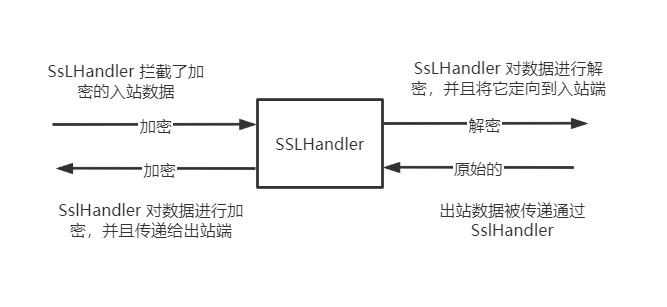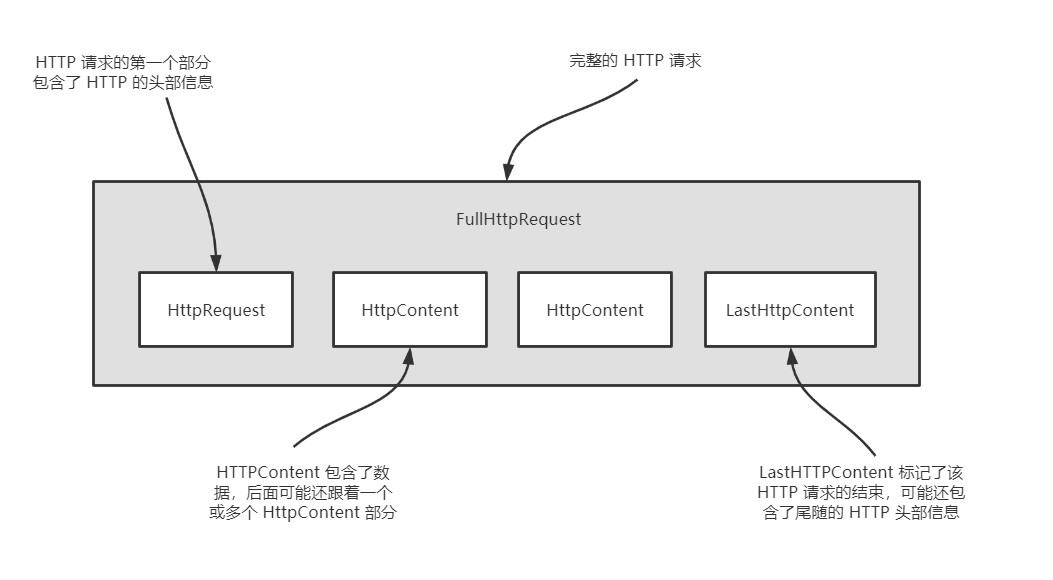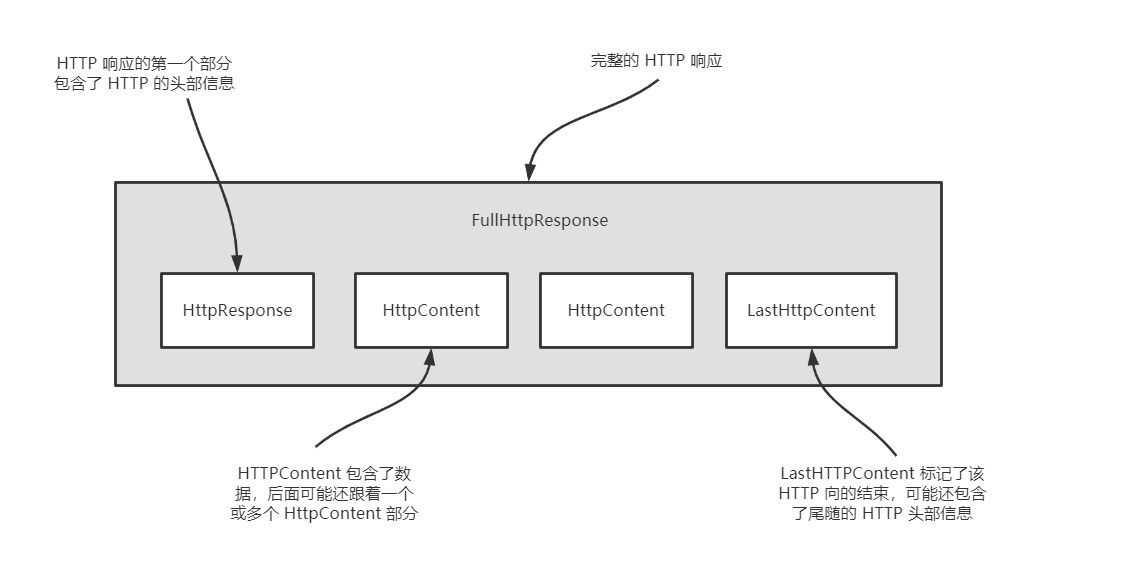Secure applications via SSL/TLS
SSL and TLS security protocols are superimposed on other protocols to achieve data security. To support SSL/TLS, Java provides javax net. SSL package, its SSLContext and SSLEngine classes make the implementation of decryption and encryption quite simple. Netty implements this API through a ChannelHandler called sslhandler, where sslhandler uses ssengine internally to do the actual work
Netty also provides an implementation of SSLEngine based on OpenSSL toolkit, which has better performance than SSLEngine provided by JDK. If OpenSSL is available, you can configure the netty application to use OpenSSL engine by default. If not available, netty will go back to the JDK implementation

The following code shows how to use ChannelInitializer to add SslHandler to ChannelPipeline
public class SslChannelInitializer extends ChannelInitializer<Channel> {
private final SslContext context;
private final boolean startTls;
public SslChannelInitializer(SslContext context, boolean startTls) {
this.context = context;
this.startTls = startTls;
}
@Override
protected void initChannel(Channel ch) throws Exception {
SSLEngine engine = context.newEngine(ch.alloc());
ch.pipeline().addFirst("ssl", new SslHandler(engine, startTls));
}
}
In most cases, Sslhandler will be the first ChannelHandler in ChannelPipeline, which ensures that encryption will not occur until all other channelhandlers apply their logic to the data
SslHandler has some useful methods, as shown in the table. For example, in the handshake phase, the two nodes will verify each other and agree on an encryption method. You can modify its behavior by configuring SslHandler, or provide a notification once the SSL/TLS handshake is completed. After the handshake phase, all data will be encrypted
| Method name | describe |
|---|---|
| setHandshakeTimeout(long, TimeUnit) setHandshakeTimeoutMillis(long) getHandshakeTimeoutMillis() | Set and obtain the timeout. After the timeout, handshake ChannelFuture will be notified of failure |
| setCloseNotifyTimeout(long, TimeUnit) setCloseNotifyTimeoutMillis(long) getCloseNotifyTimeoutMillis() | Set and obtain the timeout. After the timeout, a close notification will be triggered and the connection will be closed, which will also lead to the failure of notifying the ChannelFuture |
| handshakeFuture() | Return a ChannelFuture that will be notified after the handshake is completed. If the handshake has been executed previously, return a ChannelFuture that contains the results of the previous handshake |
| close() close(ChannelPipeline) close(ChannelHandlerContext, ChannelPromise) | Send close_notify to request the shutdown and destruction of the underlying SslEngine |
HTTP codec
HTTP is based on the request / response mode. The client sends an HTTP request to the server, and then the server will return an HTTP response. Netty provides a variety of encoders and decoders to simplify the use of this protocol
The following figure shows the methods of producing and consuming HTTP requests and HTTP responses respectively


As shown in the figure, an HTTP request / response may consist of multiple data parts and always ends with a LastHttpContent part
The following table outlines the HTTP decoders and encoders that process and generate these messages
| name | describe |
|---|---|
| HttpRequestEncoder | Encode HTTPRequest, HttpContent, and LastHttpContent messages into bytes |
| HttpResponseEncoder | Encode HTTPResponse, HttpContent, and LastHttpContent messages into bytes |
| HttpRequestDecoder | Encode bytes into HTTPRequest, HttpContent, and LastHttpContent messages |
| HttpResponseDecoder | Encode bytes into HTTPResponse, HttpContent, and LastHttpContent messages |
The HttpPipelineInitializer class in the following code shows how easy it is to add HTTP support to your application - just add the correct ChannelHandler to ChannelPipeline
public class HttpPipelineInitializer extends ChannelInitializer<Channel> {
private final boolean client;
public HttpPipelineInitializer(boolean client) {
this.client = client;
}
@Override
protected void initChannel(Channel ch) throws Exception {
ChannelPipeline pipeline = ch.pipeline();
if (client) {
// If it is a client, add HttpResponseDecoder to process the response from the server
pipeline.addLast("decoder", new HttpResponseDecoder());
// If it is a client, add httprequesteencoder to send a request to the server
pipeline.addLast("encoder", new HttpRequestEncoder());
} else {
// If it is a server, add an HttpRequestDecoder to process requests from the client
pipeline.addLast("decoder", new HttpRequestDecoder());
// If it is a client, add HttpResponseEncoder to send a response to the client
pipeline.addLast("encoder", new HttpResponseEncoder());
}
}
}
Aggregate HTTP messages
After the ChannelInitializer installs the ChannelHandler into the ChannelPipeline, you can handle different types of HTTP object messages. However, since HTTP requests and responses may consist of many parts, you need to aggregate them to form a complete message. Netty provides an aggregator that can combine multiple message parts into FullHttpRequest or FullHttpResponse messages
Since message segments need to be buffered until the next complete message can be forwarded to the next ChannelInboundHandler, this operation has a slight overhead. The advantage is that you don't have to care about message fragments
The introduction of this automatic aggregation mechanism is just to add another ChannelHandler to the ChannelPipeline. The following code shows how to do this:
public class HttpAggregatorInitializer extends ChannelInitializer<Channel> {
private final boolean isClient;
public HttpAggregatorInitializer(boolean isClient) {
this.isClient = isClient;
}
@Override
protected void initChannel(Channel ch) throws Exception {
ChannelPipeline pipeline = ch.pipeline();
if (isClient) {
// If it is a client, add HttpClientCodec
pipeline.addLast("codec", new HttpClientCodec());
} else {
// If it is a server, add HttpServerCodec
pipeline.addLast("codec", new HttpServerCodec());
}
// Add an HTTPObjectAggregator with a maximum message size of 512KB to the ChannelPipeline
pipeline.addLast("aggregator", new HttpObjectAggregator(512 * 1024));
}
}
HTTP compression
When using HTTP, it is recommended to turn on the compression function to reduce the size of transmitted data as much as possible. Although compression can be costly, it is generally a good idea, especially for text data
Netty provides a ChannelHandler implementation for both compression and decompression, which supports both gzip and deflate coding
The client can indicate the compression format supported by the server by providing the following header information
GET /encrypted-area HTTP/1.1
Host: www.example.com
Accept-Encoding: gzip, deflate
However, it should be noted that the server has no obligation to compress the data it sends
public class HttpCompressionInitializer extends ChannelInitializer<Channel> {
private final boolean isClient;
public HttpCompressionInitializer(boolean isClient) {
this.isClient = isClient;
}
@Override
protected void initChannel(Channel ch) throws Exception {
ChannelPipeline pipeline = ch.pipeline();
if (isClient) {
// If it is a client, add http clientcodec
pipeline.addLast("codec", new HttpClientCodec());
// If it is a client, add HttpContentDecompressor to process compressed content from the server
pipeline.addLast("decompressor", new HttpContentDecompressor());
} else {
// If it is a server, add HttpServerCodec
pipeline.addLast("codec", new HttpServerCodec());
// If it is a server, add HttpContentDecompressor to compress the data
pipeline.addLast("decompressor", new HttpContentDecompressor());
}
}
}
HTTPS
To enable HTTPS, you only need to add SslHandler to the ChannelHandler combination of ChannelPipeline
public class HttpsCodecInitializer extends ChannelInitializer<Channel> {
private final SslContext context;
private final boolean isClient;
public HttpsCodecInitializer(SslContext context, boolean isClient) {
this.context = context;
this.isClient = isClient;
}
@Override
protected void initChannel(Channel ch) throws Exception {
ChannelPipeline pipeline = ch.pipeline();
SSLEngine engine = context.newEngine(ch.alloc());
pipeline.addLast("ssl", new SslHandler(engine));
if (isClient) {
pipeline.addLast("codec", new HttpClientCodec());
} else {
pipeline.addLast("codec", new HttpServerCodec());
}
}
}
WebSocket
WebSocket solves a long-standing problem: since the underlying protocol (HTTP) is an interactive sequence of request / response mode, how to publish information in real time? AJAX solves this problem to some extent, but the data flow is still driven by the request sent by the client
WebSocket provides two-way communication over a single TCP connection. It provides an alternative to HTTP polling for two-way communication between web pages and remote servers
To add WebSocket support to your application, you need to add the appropriate client or server WebSocketChannelHandler to the ChannelPipeline. This class will handle the special message type called frame defined by WebSocket. As shown in the table, WebSocketFrame can be classified as data frame or control frame
| name | describe |
|---|---|
| BinaryWebSocketFrame | Data frames: binary data |
| TextWebSocketFrame | Data frames: text data |
| ContinuationWebSocketFrame | Data frame: text or binary data belonging to the previous BinaryWebSocketFrame or TextWebSocketFrame |
| CloseWebSocketFrame | Control frame: a CLOSE request, closing status code and closing reason |
| PingWebSocketFrame | Control frame: request a PongWebSocketFrame |
| PongWebSocketFrame | Control frame: response to PingWebSocketFrame request |
Because Netty is mainly a server-side technology, we focus on creating WebSocket server. The following code shows a simple example of using WebSocketChannelHandler. This class will handle protocol upgrade handshake and three control frames - Close, Ping and Pong. Text and Binary data frames will be passed to the next ChannelHandler for processing
public class WebSocketServerInitializer extends ChannelInitializer<Channel> {
@Override
protected void initChannel(Channel ch) throws Exception {
ch.pipeline().addLast(
new HttpServerCodec(),
new HttpObjectAggregator(65536),
// If the requested endpoint is / websocket, the upgrade handshake is processed
new WebSocketServerProtocolHandler("/websocket"),
// TextFrameHandler handles TextWebSocketFrame
new TextFrameHandler(),
// BinaryFrameHandler handles BinaryWebSocketFrame
new BinaryFrameHandler(),
// ContinuationFrameHandler handles continuationwebsocketframe
new ContinuationFrameHandler());
}
public static final class TextFrameHandler extends SimpleChannelInboundHandler<TextWebSocketFrame> {
@Override
protected void messageReceived(ChannelHandlerContext ctx, TextWebSocketFrame msg) throws Exception {
// do something
}
}
public static final class BinaryFrameHandler extends SimpleChannelInboundHandler<BinaryWebSocketFrame> {
@Override
protected void messageReceived(ChannelHandlerContext ctx, BinaryWebSocketFrame msg) throws Exception {
// do something
}
}
public static final class ContinuationFrameHandler extends SimpleChannelInboundHandler<ContinuationWebSocketFrame> {
@Override
protected void messageReceived(ChannelHandlerContext ctx, ContinuationWebSocketFrame msg) throws Exception {
// do something
}
}
}